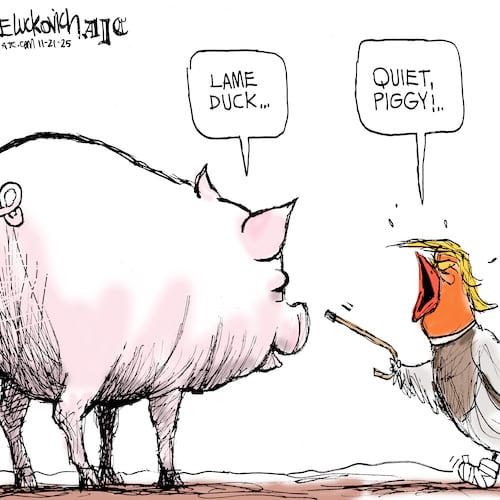Yes.
By most measures, U.S. economy does better in divided government.
By Kevin Hassett
With respect to Abraham Lincoln, a house divided against itself often prospers.
Since 1970, the levers of federal government — the White House, Senate and House of Representatives — have been in the hands of one party, whether Republican or Democrat, 30 percent of the time. The U.S. economy has been healthier the other 70 percent of the time. First let’s look at gross domestic product.
From 1970, median GDP has grown 3.3 percent in years of divided government (1970-76, 1981-92, 1995-2002, 2007- 08), compared with 3 percent when government was unified (1977-80, 1993-94, 2003-06, 2009-10).
How about unemployment? Since 1970, median unemployment has been 6.1 percent under one-party rule, 5.7 percent when both parties have some control.
Equity markets have practically jumped for joy at political division. Since 1970, the Standard & Poor’s 500 Index has increased at a median rate of 13.5 percent per year in divided times and 9 percent per year under one-party rule.
I can think of two explanations for the improved performance of our economy when the government is divided.
Under the “politicians are idiots” view, divided governments tend to be gridlocked. A paralyzed government is a boon to the economy because the changes that politicians contrive tend to be harmful.
Under the “politicians are sensible” view, divided governments produce better lawmaking because only sensible policies can achieve the necessary bipartisan support.
When government is controlled by one party, common sense is cast aside as those in power use their muscle to reward friends and punish enemies.
One crude way to cast light on the relative merits of the two views is to test the gridlock theory directly. Does legislative activity tend to grind to a halt when government is divided?
Since 1993, divided governments have passed a median of 241 bills into law each year, while unified governments have passed 210.
This is, of course, not decisive evidence, because the number of passed bills is irrelevant if the legislation is meaningless. (Anybody want to name a post office?) Anecdotally, though, some of the great moments in modern legislation, such as the Tax Reform Act of 1986 and the Personal Responsibility and Work Opportunity Act of 1996, also known as welfare reform, were passed when each party enjoyed some control in Washington.
There is also some evidence that divided governments have been more fiscally responsible, especially recently. The median federal budget deficit as a percentage of GDP has been 2.7 percent since 1970 under both formats of government, slightly lower (3.1 percent vs. 3.4 percent) in divided times since 1981 and even better (1.2 percent vs. 3.4 percent) in divided times since 1993.
That last part shows that the showdown between President Bill Clinton and House Speaker Newt Gingrich offered more than good political theater; it produced some results.
It’s not hard to see how political alignment might influence our leaders’ virtue on deficits:
Republicans are attracted to deficit reduction because it constrains the big-government tendencies of Democrats, while Democrats are attracted to it because it constrains the tax-cutting of Republicans.
Deficit reduction is tough work. It shows that divided government can’t easily be written off as inevitable gridlock.
As President Barack Obama and his team look ahead to the prospect of governing in collaboration with Republicans, they should look at history, and they should take heart. They can still think big, so long as they think sensibly.
Kevin Hassett, director of economic-policy studies at the American Enterprise Institute, is a Bloomberg News columnist.
No.
Structural flaws in economy won’t get fixed in gridlocked Congress.
By Mohamed A. El-Erian
With the two chambers of Congress split between Democrats and Republicans, the conventional wisdom likely to be repeated over the next few weeks is that political gridlock is good for the economy. While often true, that is not the case today.
Such thinking is based on the view that political gridlock inhibits or paralyzes economically unproductive government actions. With government out of the way, it follows that the private sector can allocate capital to the most productive uses.
But this view is most applicable to a private sector that is in good shape — businesses and households with robust balance sheets, positive cash flow and access to credit. In such a world, the path of least resistance translates into higher economic growth and jobs.
Today, many large companies and rich households are in a good position to move forward. They have the means to spend and hire. Yet they lack the willingness to do either, as illustrated by massive cash holdings and efforts to reduce risk in balance sheets and investment portfolios.
Many of these companies and households explain the divergence between their will and their wallet by pointing to regulatory and tax uncertainty, the absence of a clear macroeconomic vision and the notion that the Obama administration is “anti-business.” They have a point in complaining about what economists call unhelpful “regime uncertainty.” Moreover, many believe that political gridlock is preferable to what they perceive as misguided government activism of the past two years. Yet this ignores a glaring reality.
For too many segments of our society, the ability to spend and hire is constrained by stubbornly high unemployment, annihilative debts and, in some cases, concerns about losing one’s home. As a whole, the United States is still overcoming the legacy of years of over-leverage and misplaced confidence that consumption can be financed by borrowing rather than earnings. The resulting debt act as strong headwinds to growth and employment.
Rather than able and willing to move forward unhindered if the government simply gets out of the way, this is a private sector that faces too many headwinds. High economic growth and job creation require not only that the private sector moves forward but also that it attains critical mass.
While certain sectors of the economy are in control of their destinies, the private sector as a whole is not in a position to do this. It needs help to overcome the consequences of the “great age” of leverage, debt and credit entitlement, and the related surge in structural unemployment. The urgency to do so increases in the rapidly evolving global economy, as United States gives a bit more of its economic and political edge to other countries daily.
Simply put, these realities make it necessary for Washington to resist two years of gridlock and policy paralysis. Democrats and Republicans must meet in the middle to implement policies to deal with debt and structural rigidities. The economy needs political courage that transcends expediency in favor of long-term solutions on housing reform, medium-term budget rules, pro-growth tax reforms, investments in physical and technological infrastructure, job retraining, greater support for education and scientific research, and better nets to protect the most vulnerable segments of society.
This is not an easy list. It will be difficult to translate today’s political extremes into a common vision, analysis and narrative. Yet the longer it takes, the greater the effort that will be needed to restore our tradition of unmatched economic dynamism, buoyant job creation and global leadership.
Mohamed A. El-Erian is chief executive and co-chief investment officer of the investment firm Pimco and author of the 2008 book “When Markets Collide.”
About the Author
Keep Reading
The Latest
Featured


